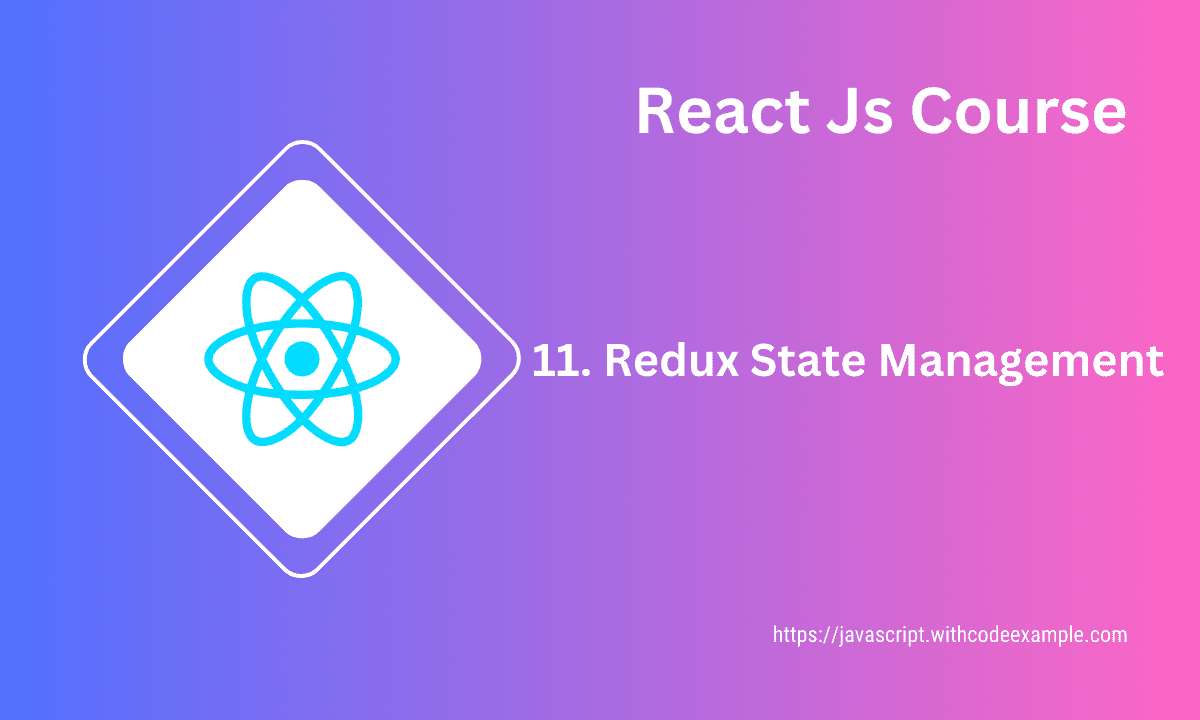Redux State Management Simplified

Redux is a state management library for JavaScript applications, particularly useful in managing the state of large and complex applications. It provides a predictable and centralized way to manage the application’s state and makes it easier to understand, debug, and maintain the state transitions.
Key Concepts of Redux:
- Store: The single source of truth for the entire application’s state. It holds the application state and provides methods to access, update, and subscribe to changes in the state.
- Actions: Plain JavaScript objects that describe changes to the state. They are dispatched to the store to trigger state updates.
- Reducers: Pure functions that specify how the state should change in response to an action. Reducers take the current state and an action as arguments and return a new state.
- Dispatch: A method provided by the store that is used to send actions to the store. Dispatching an action triggers the state update process.
- Selectors: Functions used to retrieve specific data from the state. Selectors help in decoupling the components from the shape of the state.
- Middleware: Middleware functions can intercept dispatched actions before they reach the reducer. This allows for additional logic such as asynchronous operations, logging, etc.
Understanding the need for state management
State management is a crucial aspect of building applications, especially those that are complex, data-intensive, or involve dynamic user interactions. It refers to the management of the data that an application uses to function, such as user input, UI state, and data fetched from APIs. While simple applications might be able to manage their state within individual components, more sophisticated applications can benefit significantly from using a dedicated state management solution like Redux. Here’s why state management is important:
- Centralized State: As your application grows, managing state becomes more complex. Having a centralized location (like a Redux store) to store and manage all your application’s data simplifies the data flow and makes it easier to reason about.
- Data Sharing: Different components across your application might need access to the same data. Instead of passing data through prop drilling (passing data through multiple components), a state management solution can provide data to components regardless of their position in the component tree.
- Predictable State Changes: In a large application, managing state changes consistently and in a predictable manner can be challenging. State management libraries, like Redux, enforce a strict unidirectional data flow and provide clear rules for updating the state.
- Separation of Concerns: Decoupling your UI components from the data and logic used to manage that data makes your codebase more maintainable. Components can focus on rendering UI, while state management takes care of the data.
- Debugging and Logging: Centralized state management systems often come with debugging tools that make it easier to inspect, trace, and replay state changes. This is especially valuable when tracking down issues in a complex application.
- Time Travel Debugging: Some state management solutions, like Redux, offer time-travel debugging, allowing you to go back and forth through the application’s state changes to identify bugs and understand how the UI reached its current state.
- Server Communication: When dealing with asynchronous operations, like data fetching from APIs, centralized state management can help coordinate these operations and ensure that data consistency is maintained.
- Reusable Components: State management facilitates the creation of reusable components that can be used in different parts of the application without worrying about how they access or manipulate data.
- Testing: Centralized state management can improve testability as you can test state transitions and UI behavior more effectively without tightly coupling tests to specific component hierarchies.
- Scalability: As your application scales, managing state in a structured way becomes crucial to maintaining a manageable codebase and preventing issues related to data synchronization and consistency.
In summary, state management provides a structured and efficient way to handle the data and state changes in your application, making it more maintainable, scalable, and easier to debug. While it might not be necessary for every application, as your project grows in complexity, using a dedicated state management solution can significantly improve your development experience and the quality of your application.
Principles of Redux
Redux follows a set of core principles that guide its design and usage. These principles help developers create well-structured, maintainable, and predictable state management in their applications. Here are the key principles of Redux:
- Single Source of Truth:
The entire application’s state is stored in a single JavaScript object called the “store.” This makes it easy to manage and access the current state of the application. - State is Read-Only:
The state in Redux is immutable. You cannot directly modify the state. Instead, you create a new state object whenever a change is needed. This ensures predictability and simplifies tracking state changes. - Changes are Made with Pure Functions:
State changes are made through pure functions called “reducers.” A reducer takes the current state and an action as input and returns a new state. These functions are predictable, making debugging and testing easier. - Changes are Described with Actions:
Actions are plain JavaScript objects that describe changes to the state. They must have atypeproperty to indicate the type of action and can optionally have additional data payloads. - Redundancy is Minimized:
Reducers should not perform complex logic or side effects. They should be pure functions that only calculate the new state based on the previous state and the action. Any complex logic or side effects can be moved to middleware. - Changes are Made One by One:
Redux enforces a unidirectional data flow. Changes are initiated by dispatching actions, and those actions flow through the reducers to update the state. This predictability simplifies tracking state changes. - State Updates are Predictable:
Since reducers are pure functions and actions are dispatched in a consistent manner, the state updates are predictable. Given a specific state and action, the outcome is always the same. - Use Middleware for Asynchronous Actions:
Middleware is used for handling asynchronous operations and side effects. It allows you to dispatch actions that can trigger asynchronous tasks, like data fetching, and then dispatch further actions once those tasks are complete. - DevTools for Debugging:
Redux provides developer tools that allow you to inspect the state changes, time-travel through state history, and debug your application more effectively. - Easily Integrates with UI Libraries:
Redux can be integrated with various UI libraries and frameworks like React, Angular, and Vue. This integration enables these libraries to efficiently update their UI based on the state changes managed by Redux.
By adhering to these principles, Redux offers a well-structured, maintainable, and scalable way to manage the state of your application. It helps in creating applications that are easier to debug, test, and extend.
Actions, reducers, and the store
Sure, let’s walk through a simple example of how to use actions, reducers, and the store in Redux. In this example, we’ll create a basic shopping cart application.
1. Define Actions:
Actions are plain JavaScript objects that describe what happened in your application. They are dispatched to the store to trigger state updates. Let’s define some actions for our shopping cart:
// actions.js
export const addToCart = (item) => {
return {
type: 'ADD_TO_CART',
payload: item,
};
};
export const removeFromCart = (itemId) => {
return {
type: 'REMOVE_FROM_CART',
payload: itemId,
};
};
2. Create Reducers:
Reducers are pure functions that specify how the state should change in response to actions. They take the current state and an action, and return a new state. Here are the reducers for our shopping cart:
// reducers.js
const initialState = {
cartItems: [],
};
const cartReducer = (state = initialState, action) => {
switch (action.type) {
case 'ADD_TO_CART':
return {
...state,
cartItems: [...state.cartItems, action.payload],
};
case 'REMOVE_FROM_CART':
return {
...state,
cartItems: state.cartItems.filter(item => item.id !== action.payload),
};
default:
return state;
}
};
export default cartReducer;
3. Create the Store:
The store is where your application state is held. It’s created using the createStore function from Redux and is passed your root reducer. In this example, we have a single reducer for the shopping cart:
// store.js
import { createStore } from 'redux';
import cartReducer from './reducers';
const store = createStore(cartReducer);
export default store;
Connecting React components to the Redux store
Now you can use the Redux store in your components to access and update the state. Here’s how you can use the store in a React component:
// ShoppingCart.js
import React from 'react';
import { useSelector, useDispatch } from 'react-redux';
import { addToCart, removeFromCart } from './actions';
const ShoppingCart = () => {
const cartItems = useSelector(state => state.cartItems);
const dispatch = useDispatch();
const handleAddToCart = (item) => {
dispatch(addToCart(item));
};
const handleRemoveFromCart = (itemId) => {
dispatch(removeFromCart(itemId));
};
return (
<div>
<h2>Shopping Cart</h2>
<ul>
{cartItems.map(item => (
<li key={item.id}>
{item.name}
<button onClick={() => handleRemoveFromCart(item.id)}>Remove</button>
</li>
))}
</ul>
<button onClick={() => handleAddToCart({ id: 1, name: 'Item 1' })}>Add Item 1</button>
</div>
);
};
export default ShoppingCart;
In this example, we’re using the useSelector hook to access the cartItems from the store, and the useDispatch hook to get the dispatch function. When the “Add Item 1” button is clicked, it dispatches the addToCart action, and when the “Remove” button is clicked, it dispatches the removeFromCart action.
By following this pattern, you’ve created a simple shopping cart application that uses Redux for state management. The actions, reducers, and store work together to manage the application’s state changes in a structured and predictable way.



